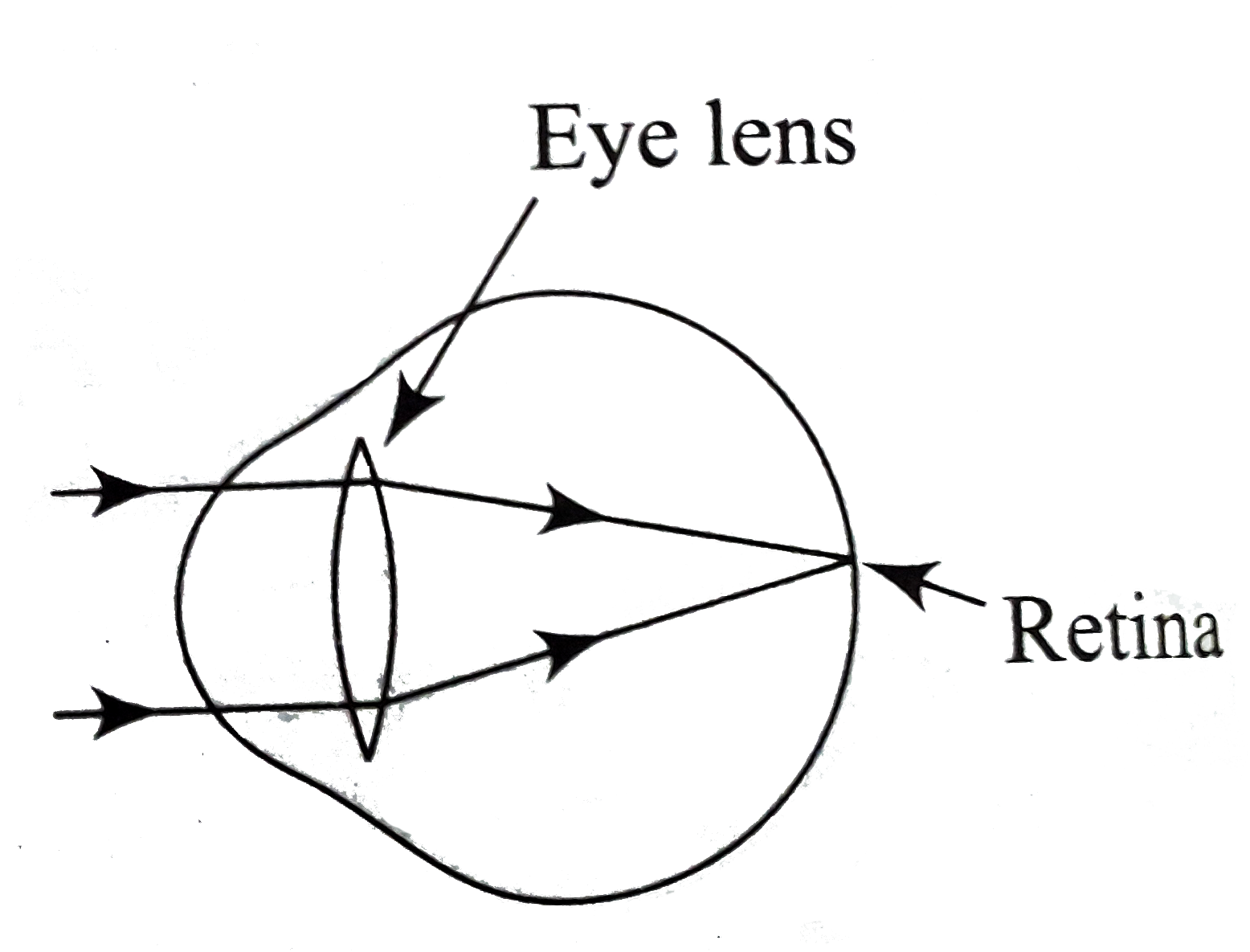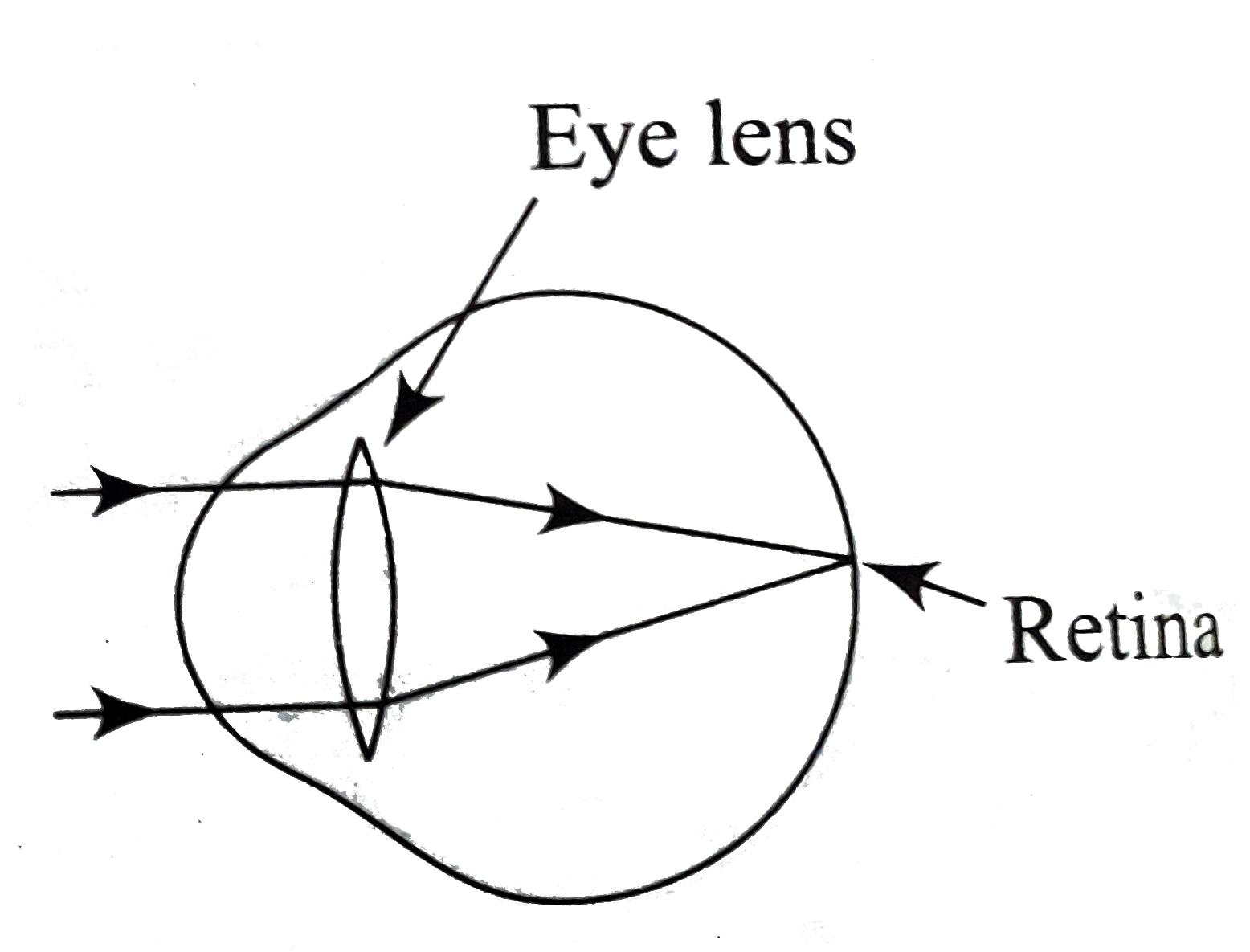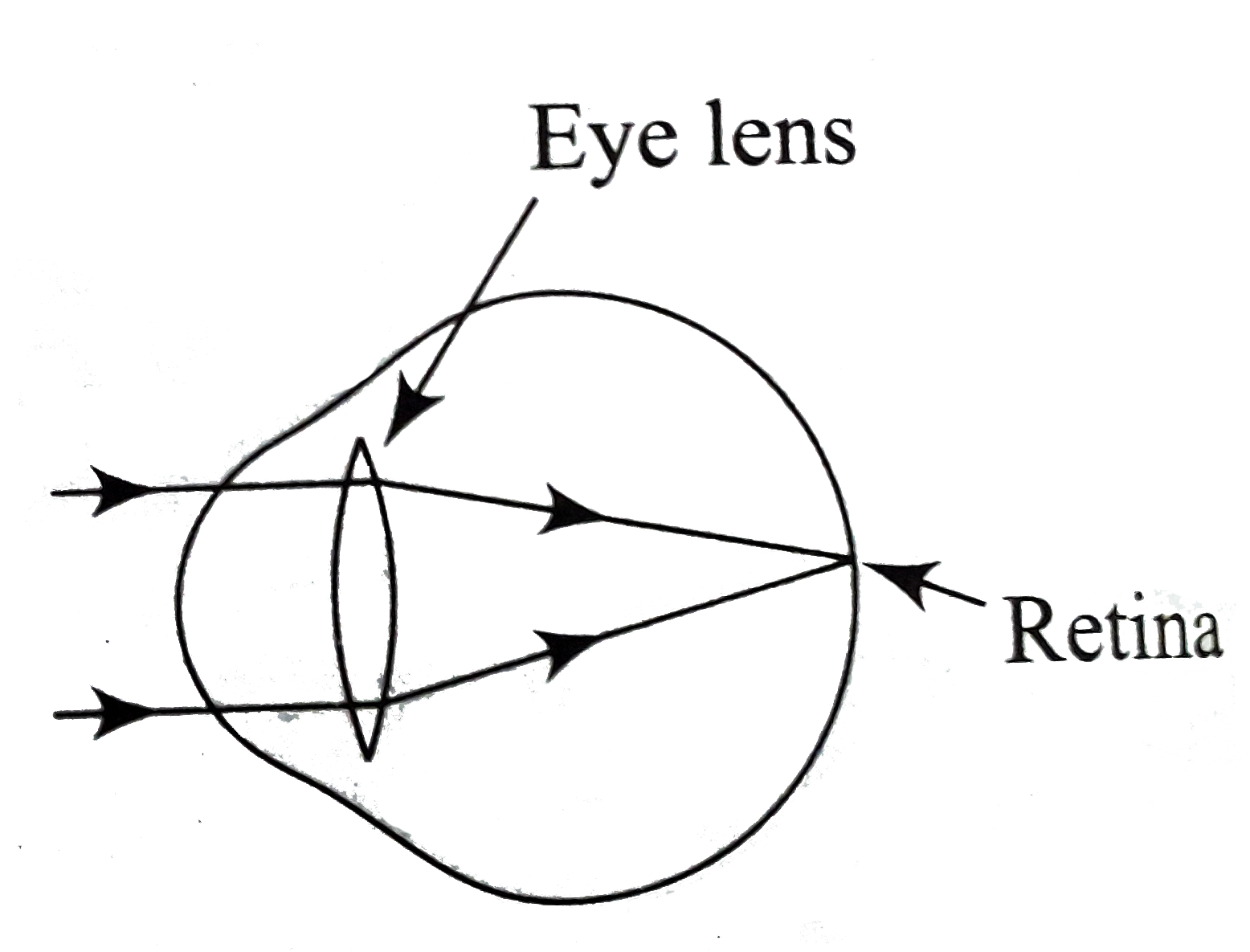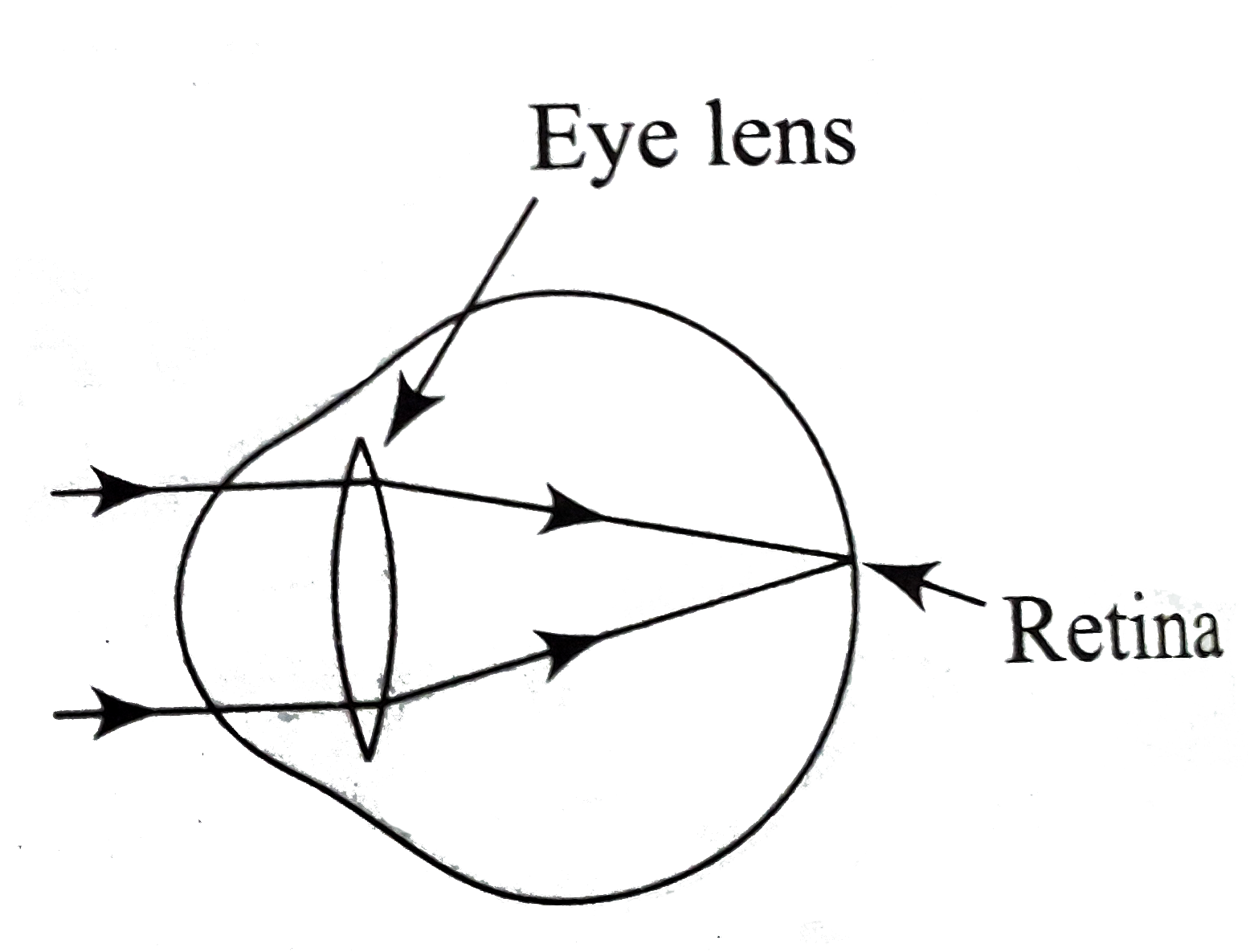A myopia person has been using spectacles of power −1.0 dioptre for distant vision. During old age, he also needs to use separate reading glasses of power +2.0 dioptre. Explain what may have happened.
To understand the situation of a myopic person who uses spectacles of power -1.0 dioptre for distant vision and later requires reading glasses of power +2.0 dioptre, we can break down the explanation into several steps:
Step 1: Understanding Myopia
Myopia, or nearsightedness, is a condition where distant objects appear blurry while close objects can be seen clearly. This occurs because the eye's shape causes light rays to focus in front of the retina.
Step 2: Power of the Spectacles
The power of the spectacles used by the myopic person is -1.0 dioptre. The formula for the power (P) of a lens is given by:
P=1f
where f is the focal length in meters.
For a power of -1.0 dioptre:
−1=1f
This implies:
f=−1 meter=−100 cm
Step 3: Far Point of the Myopic Eye
The negative focal length indicates that the far point of the myopic person is at 100 cm. This means that the person can see objects clearly up to 100 cm away, but anything beyond that appears blurry.
Step 4: Normal Near Point
The normal near point for a healthy eye is typically around 25 cm. The myopic person can see objects clearly between 25 cm and 100 cm due to the eye's ability to accommodate, which allows focusing on objects at varying distances.
Step 5: Changes with Age
As people age, the ability of the eye to accommodate diminishes. This means that the near point, which is normally 25 cm, may change to a farther distance, for example, 50 cm.
Step 6: New Near Point Calculation
With the new near point at 50 cm, we can calculate the required power of the reading glasses. The new near point (U) is -50 cm (the negative sign indicates that the object is virtual for the lens). The normal near point (V) is -25 cm.
Using the lens formula:
1f=1v−1u
Substituting the values:
1f=1−25−1−50
1f=−125+150
Finding a common denominator (50):
1f=−250+150
1f=−150
Thus,
f=−50 cm
Step 7: Power of the Reading Glasses
Now, we can find the power of the reading glasses:
P=1f=1−0.5=−2 dioptres
Since the person requires a positive lens for reading, the power of the reading glasses is +2.0 dioptres.
Conclusion
In summary, the myopic person initially used -1.0 dioptre spectacles for distant vision. With age, their near point shifted from 25 cm to 50 cm due to decreased accommodation ability, necessitating the use of +2.0 dioptre reading glasses.
---
Myopia, or nearsightedness, is a condition where distant objects appear blurry while close objects can be seen clearly. This occurs because the eye's shape causes light rays to focus in front of the retina.
The power of the spectacles used by the myopic person is -1.0 dioptre. The formula for the power (P) of a lens is given by:
P=1f
where f is the focal length in meters.
−1=1f
This implies:
f=−1 meter=−100 cm
The negative focal length indicates that the far point of the myopic person is at 100 cm. This means that the person can see objects clearly up to 100 cm away, but anything beyond that appears blurry.
The normal near point for a healthy eye is typically around 25 cm. The myopic person can see objects clearly between 25 cm and 100 cm due to the eye's ability to accommodate, which allows focusing on objects at varying distances.
As people age, the ability of the eye to accommodate diminishes. This means that the near point, which is normally 25 cm, may change to a farther distance, for example, 50 cm.
With the new near point at 50 cm, we can calculate the required power of the reading glasses. The new near point (U) is -50 cm (the negative sign indicates that the object is virtual for the lens). The normal near point (V) is -25 cm.
1f=1v−1u
Substituting the values:
1f=1−25−1−50
1f=−125+150
Finding a common denominator (50):
1f=−250+150
1f=−150
Thus,
f=−50 cm
Now, we can find the power of the reading glasses:
P=1f=1−0.5=−2 dioptres
Since the person requires a positive lens for reading, the power of the reading glasses is +2.0 dioptres.
In summary, the myopic person initially used -1.0 dioptre spectacles for distant vision. With age, their near point shifted from 25 cm to 50 cm due to decreased accommodation ability, necessitating the use of +2.0 dioptre reading glasses.
Topper's Solved these Questions
- BOOK - DC PANDEY ENGLISHCHAPTER - RAY OPTICSEXERCISE - Checkpoint 9.110videos
RAY OPTICS
- BOOK - DC PANDEY ENGLISHCHAPTER - RAY OPTICSEXERCISE - Checkpoint 9.210videos
RAY OPTICS
- BOOK - DC PANDEY ENGLISHCHAPTER - NUCLEIEXERCISE - C MADICAL ENTRANCES GALLERY46videos
NUCLEI
- BOOK - DC PANDEY ENGLISHCHAPTER - REFLECTION OF LIGHTEXERCISE - Subjective9videos
REFLECTION OF LIGHT
Similar Questions
A person has near point at 100 cm. What power of lens is needed to read at 20 cm if he/she uses (a) contact lens, (b) spectacles having glasses 2.0 cm separated from the eyes?
View SolutionA person wears eye glasses with a power of −5.5D for distance viewing. His doctor prescribes a correction of +1.5D for his near vision. What is the focal length of the lens used for correcting (i) distant vision and (ii) near vision?
View SolutionA far sighted person has a near point of 60cm . What power lens should be used for eye glasses such that the person can be read this book at a distance of 25 cm.
View SolutionThe ciliary muscles of eye control the curvature of the lens in the eye and hence can alter the effective focal length of the system. When the muscles are fully relaxed, the focal length is maximum. When the muscles are strained, the curvature of lens increases. That means radius of curvature decreases and focal length decreases. For a clear vision, the image must be on the retina. The image distance is therefore fixed for clear vision and it equals the distance of retina from eye lens. It is about 2.5cm for a grown up person.
A perosn can theoretically have clear vision of an object situated at any large distance from the eye. The smallest distance at which a person can clearly see is related to minimum possible focal length. The ciliary muscles are most strained in this position. For an average grown up person, minimum distance of the object should be around 25cm.
A person suffering from eye defects uses spectacles (eye glass). The function of lens of spectacles is to form the image of the objects within the range in which the person can see clearly. The image o the spectacle lens becomes object for the eye lens and whose image is formed on the retina.
The number of spectacle lens used for th eremedy of eye defect is decided by the power fo the lens required and the number of spectacle lens is equal to the numerical value of the power of lens with sign. For example, if power of the lens required is +3D (converging lens of focal length 100/3cm ), then number of lens will be +3.
For all the calculations required, you can use the lens formula and lensmaker's formula. Assume that the eye lens is equiconvex lens. Neglect the distance between the eye lens and the spectacle lens.

Q. A far sighted man connot see objects clearly unless they are at least 100cm from his eyes. The number of the spectacle lenses that will make his range of clear vision equal to an average grown up person will beView Solution(a) A student suffering from myopia is not able to see distinctly the objects placed beyond 5m. Two possible reasons due to which this defect of vision may have arisen. With the help of ray diagrams, explain :
(i) Why the student is unable to see distinctly the objects placed beyond 5m from his eyes.
(ii) The type of corrective lens used to restore proper vision and how this defect is corrected by the use of this lens.
(b) If in this case, numerical value of focal length of corrective lens is 5m, find the power of the lens as per the new cartesion sign convention.View SolutionThe ciliary muscles of eye control the curvature of the lens in the eye and hence can alter the effective focal length of the system. When the muscles are fully relaxed, the focal length is maximum. When the muscles are strained, the curvature of lens increases. That means radius of curvature decreases and focal length decreases. For a clear vision, the image must be on the retina. The image distance is therefore fixed for clear vision and it equals the distance of retina from eye lens. It is about 2.5cm for a grown up person.
A perosn can theoretically have clear vision of an object situated at any large distance from the eye. The smallest distance at which a person can clearly see is related to minimum possible focal length. The ciliary muscles are most strained in this position. For an average grown up person, minimum distance of the object should be around 25cm.
A person suffering from eye defects uses spectacles (eye glass). The function of lens of spectacles is to form the image of the objects within the range in which the person can see clearly. The image o the spectacle lens becomes object for the eye lens and whose image is formed on the retina.
The number of spectacle lens used for th eremedy of eye defect is decided by the power fo the lens required and the number of spectacle lens is equal to the numerical value of the power of lens with sign. For example, if power of the lens required is +3D (converging lens of focal length 100/3cm ), then number of lens will be +3.
For all the calculations required, you can use the lens formula and lensmaker's formula. Assume that the eye lens is equiconvex lens. Neglect the distance between the eye lens and the spectacle lens.

Q. A person can see objects clearly from distance 10cm to ∞. Then, we can say that the person isView SolutionThe ciliary muscles of eye control the curvature of the lens in the eye and hence can alter the effective focal length of the system. When the muscles are fully relaxed, the focal length is maximum. When the muscles are strained, the curvature of lens increases. That means radius of curvature decreases and focal length decreases. For a clear vision, the image must be on the retina. The image distance is therefore fixed for clear vision and it equals the distance of retina from eye lens. It is about 2.5cm for a grown up person.
A perosn can theoretically have clear vision of an object situated at any large distance from the eye. The smallest distance at which a person can clearly see is related to minimum possible focal length. The ciliary muscles are most strained in this position. For an average grown up person, minimum distance of the object should be around 25cm.
A person suffering from eye defects uses spectacles (eye glass). The function of lens of spectacles is to form the image of the objects within the range in which the person can see clearly. The image o the spectacle lens becomes object for the eye lens and whose image is formed on the retina.
The number of spectacle lens used for th eremedy of eye defect is decided by the power fo the lens required and the number of spectacle lens is equal to the numerical value of the power of lens with sign. For example, if power of the lens required is +3D (converging lens of focal length 100/3cm ), then number of lens will be +3.
For all the calculations required, you can use the lens formula and lensmaker's formula. Assume that the eye lens is equiconvex lens. Neglect the distance between the eye lens and the spectacle lens.

Q. A near sighted man can clearly see ojects only upto a distance of 100cm and not beyond this. The number of the spectacle lenses necessary for the remedy of this defect will beView SolutionThe ciliary muscles of eye control the curvature of the lens in the eye and hence can alter the effective focal length of the system. When the muscles are fully relaxed, the focal length is maximum. When the muscles are strained, the curvature of lens increases. That means radius of curvature decreases and focal length decreases. For a clear vision, the image must be on the retina. The image distance is therefore fixed for clear vision and it equals the distance of retina from eye lens. It is about 2.5cm for a grown up person.
A perosn can theoretically have clear vision of an object situated at any large distance from the eye. The smallest distance at which a person can clearly see is related to minimum possible focal length. The ciliary muscles are most strained in this position. For an average grown up person, minimum distance of the object should be around 25cm.
A person suffering from eye defects uses spectacles (eye glass). The function of lens of spectacles is to form the image of the objects within the range in which the person can see clearly. The image o the spectacle lens becomes object for the eye lens and whose image is formed on the retina.
The number of spectacle lens used for th eremedy of eye defect is decided by the power fo the lens required and the number of spectacle lens is equal to the numerical value of the power of lens with sign. For example, if power of the lens required is +3D (converging lens of focal length 100/3cm ), then number of lens will be +3.
For all the calculations required, you can use the lens formula and lensmaker's formula. Assume that the eye lens is equiconvex lens. Neglect the distance between the eye lens and the spectacle lens.

Q. Maximum focal length of a eye lens of a normal person isView SolutionThe ciliary muscles of eye control the curvature of the lens in the eye and hence can alter the effective focal length of the system. When the muscles are fully relaxed, the focal length is maximum. When the muscles are strained, the curvature of lens increases. That means radius of curvature decreases and focal length decreases. For a clear vision, the image must be on the retina. The image distance is therefore fixed for clear vision and it equals the distance of retina from eye lens. It is about 2.5cm for a grown up person.
A perosn can theoretically have clear vision of an object situated at any large distance from the eye. The smallest distance at which a person can clearly see is related to minimum possible focal length. The ciliary muscles are most strained in this position. For an average grown up person, minimum distance of the object should be around 25cm.
A person suffering from eye defects uses spectacles (eye glass). The function of lens of spectacles is to form the image of the objects within the range in which the person can see clearly. The image o the spectacle lens becomes object for the eye lens and whose image is formed on the retina.
The number of spectacle lens used for th eremedy of eye defect is decided by the power fo the lens required and the number of spectacle lens is equal to the numerical value of the power of lens with sign. For example, if power of the lens required is +3D (converging lens of focal length 100/3cm ), then number of lens will be +3.
For all the calculations required, you can use the lens formula and lensmaker's formula. Assume that the eye lens is equiconvex lens. Neglect the distance between the eye lens and the spectacle lens.

Q. Minimum focal length of eye lens of a normal peson isView SolutionThree resistors having resistances of 1.60Ω,2.40Ω and 4.80Ω are connected in parallel to a 28.0V battery that has negligible internal resistance. Find
(a) the equivalent resistance of the combination.
(b) the current in each resistor.
(c) the total current through the battery.
(d) the voltage across each resistor.
(e) the power dissipated in each resistor.
(f) which resistor dissipates the maximum power the one with the greatest resistance or the least resistance? Explain why this should be.View Solution

